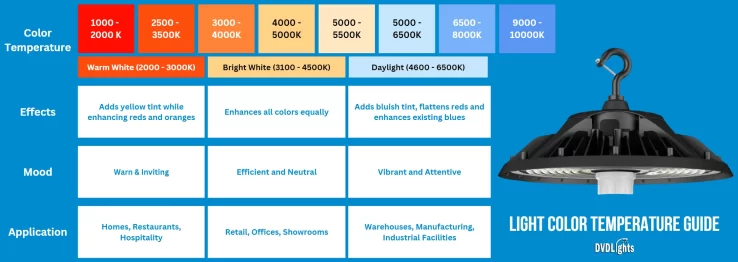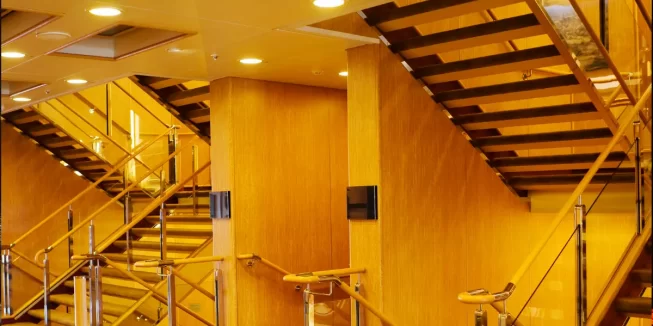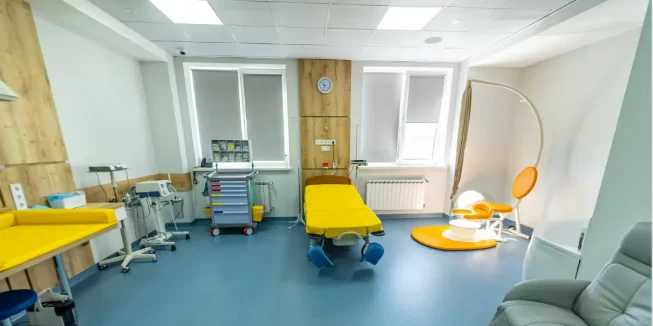Mastering Color Temperature: Your Comprehensive Lighting Guide
Are you ready to change your lights? Welcome to the Color Temperature Guide from DVDLights. When choosing the right lighting for your area, you need to know about color temperature. This guide will walk you through the basics of color temperature, so whether you’re changing the mood of your home or the lighting in your office, you can make the best choices to create the perfect atmosphere. Explore the world of lighting colors, from those that are warm and cozy to those that are cool and energizing, and learn how they can change your environment. Let’s set out on a journey to find the best lighting options for your world.

It means the color of the light that comes out of an LED bulb. It is measured in Kelvin (K) and shows how warm or cool the light seems. This is important to know if you want to make the right mood in different places.
Understanding Color Temp
It is a property of visible light that helps describe whether it is warm or cool. It has nothing to do with the temperature of the object, but rather with the color of the light it gives off. Warm light makes a room feel cozy and calm, while cool light makes it look brighter and more energetic.
The Kelvin Scale and Color Temp
Did you know that color temperature is measured using the Kelvin scale? Warm light, which is usually between 2700K and 3000K, makes a room feel cozy and friendly. On the other hand, between 4000K and 6500K is where you’ll find cool light, which helps you work and concentrate. With this information, you’ll be able to choose the right lights for any event.

Warm vs. Cool: Choosing the Right Color Temp
Whether you choose warm or cool LED color temperature relies on the mood you want to create and the application. Warm colors are often chosen for homes and places where people stay because they make the space feel cozy and welcoming. Cool color temperature, on the other hand, is good for places like offices and shops that need bright, focused lighting to do their jobs.
Applications of Different Color Temperatures
In different places, the results of different color temperatures are different. Let’s look at some popular ways to use different color temperatures:
Residential Lighting
Warm colors between 2700K and 3000K can help you make your home feel cozy and calm. These colors will make you feel right at home in your living room, bedroom, or eating room.

Commercial Lighting
Most commercial areas need lighting that is bright and energizing. Cool colors (4000K to 5000K) work well in places where efficiency and focus are important, like offices, lobbies, and workspaces.
Talk to our Light Expert Today!
CLICK TO CALL 1-800-838-5070Hospitality Lighting

Hotels, restaurants, and cafes try to make their spaces feel warm and cozy. Warm colors (2700K to 3000K) are usually used in these areas to make people feel at home and welcome.
Healthcare Lighting

In healthcare facilities, it’s important to find a balance between comfort and usefulness. Neutral colors (3500K to 4000K) often make a room look clean and professional while still making it feel calm.
Retail Lighting

The lighting in a store needs to show off the goods and make shopping interesting. Retail spaces often use cool colors (3500K to 4500K) to make products stand out and draw customers.
Get Your Free Quote Now!
LED Lighting Products
- Indoor LED Lights
- Outdoor LED Lights
- LED Downlights
- LED Linear High Bays
- LED Emergency and Exit Lights
- LED UFO high Bays
- LED Panel Lights
- LED Grow Lights
- Linear LED Strip Lights
- LED Retrofit Kits
- LED Troffers and Fixtures
- T8 LED Tubes
- LED Vapor Tight
- LED ARea Lights
- LED Canopy Lights
- LED Wall Packs
- LED Flood Lights
- Wall-Mounted LED Lights
- LED Dusk to Dawn Lights
- Light Poles Fixtures
- LED Mounting Accessories
Outdoor Lighting
Outdoor lighting is both practical and nice to look at. Think about how warm colors between 2700K and 3000K could create the right mood for your outdoor seating area. Your friends will feel at ease and like they belong. And nothing beats cool colors between 5000K and 6500K for lighting up outdoor walkways and parking lots. Trust us, your outdoor space has never looked nicer and brighter.

Considerations for LED Color Temp
It’s essential to consider the following factors:
- Purpose of the space
- Desired atmosphere
- Natural light availability
- Surrounding colors and materials
- User preferences
Factors Influencing LED Color Temp
It’s essential to consider the following factors:
- Purpose of the space
- Desired atmosphere
- Natural light availability
- Surrounding colors and materials
- User preferences
Tips for Selecting the Right LED Color Temp
Here are some tips to help you choose the right LED color temperature:
- Think about the room’s purpose and the mood you want to make.
- Use soft color temp in places where you want to relax and feel at ease.
- Choose a cool color temperature in places where you need to be productive and focused.
- Try out different color temperatures to find the right mix.
- If you need more certainty about the right color temperature for a certain task, you should talk to a professional.
Conclusion:
It is a very important thing to think about when picking lighting for different places. Understanding and choosing the right color temperature can make a big difference in the mood of a room, whether it’s a cozy living room, a productive office, or an inviting hotel lobby. When choosing the LED color temperature, it’s important to think about how the space will be used, the mood you want to set, and any other factors that could affect the result. By giving these things some thought, you can improve the environment and get what you want.
Call Us Now For Your LED Lighting Solutions ...
CLICK TO CALL 1-800-838-5070Frequently Asked Questions:
LED lights generally have higher energy efficiency than traditional bulbs. The impact of color temperature on energy consumption is negligible compared to other factors like lumen output.
LED color temperature does not pose any immediate health risks. However, excessive exposure to cool color temperatures at night may disrupt sleep patterns.
Many LED lights, including those with different color temperatures, are dimmable. Ensure compatibility between the dimmer switch and the LED bulbs.
Specific advanced LED lighting systems provide tunable color temperature options, enabling you to modify the color to suit your liking.
